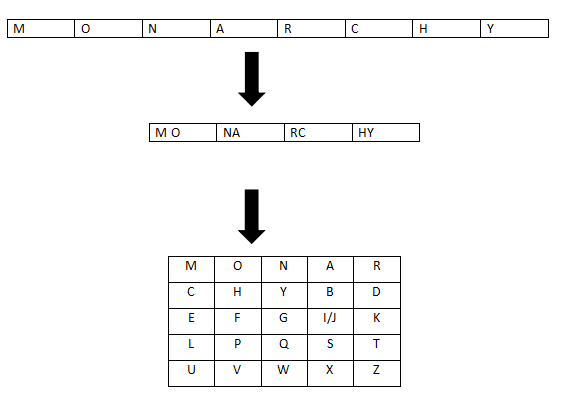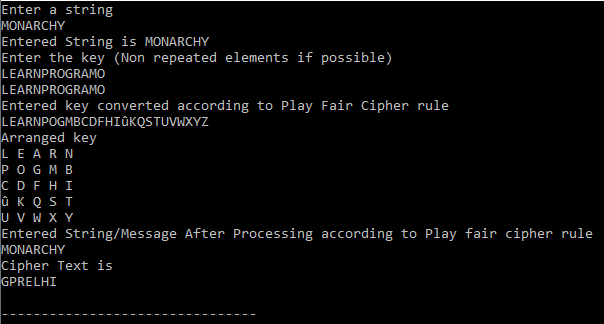Today we will learn the Playfair Cipher Program in C. Before start learning we will make you know about Playfair Cipher.
What is Playfair Cipher?
Playfair cipher. The best-known multiple-letter encryption which treats diagrams from the plaintext as solitary units and contrasts these components to ciphertext diagrams.
The Playfair cipher is a Fantastic improvement over easy monoalphabetic ciphers. The relative frequencies of individual letters show a much larger variety than that of diagrams.
Therefore identification of letters is much harder. For all these reasons, the Playfair cipher was for quite a while considered unbreakable.
It had been utilized as the standard area system from the British Army in World War I and enjoyed considerable from the U.S. Army along with other allied forces during World War II.
Despite this degree of confidence in its own safety, the Playfair cipher is relatively simple to crack because it leaves a lot of the plaintext construction. A couple of hundred letters of ciphertext are usually adequate.
The Cipher Algorithm Uses 5×5 Matrix.
For Example word ‘MONARCHY’

Output:

Here’s an illustration: In this situation, the keyword is a monarchy. The letters J and I count as a single letter.

Repeating plaintext letters which would collapse in exactly the same set are split using a filler letter. For example x, so balloon could be enciphered as ba lx lo on.
Plaintext letters which drop in the Exact Same row of this matrix are all replaced from the letter into the right, together with the first component of this row circularly after the past. By the way, ar is encoded as RM.
Plaintext letters which fall in the Exact Same column each exchanged by the letter below, with the upper element of this row circularly after the past. So my is encoded as CM.
Which is occupied by another plaintext letter. Therefore, hs become BP and ea becomes more IM (or even JM, since the encipherer wants ).
1. Playfair Cipher Program in C
In this program, we have entered the MONARCHY and the message as LEARNPROGRAMO and the final message is printed on the screen.
#include<stdio.h>
#include<string.h>
#include<ctype.h>
int removerepeated(int size,int a[]);
int insertelementat(int position,int a[],int size);
main()
{
int i,j,k,numstr[100],numcipher[100],numkey[100],lenkey,templen,tempkey[100],flag=-1,size,cipherkey[5][5],lennumstr,row1,row2,col1,col2;
char str[100],key[100];
printf("Enter a string\n");
gets(str);
//converting entered string to Capital letters
for(i=0,j=0;i<strlen(str);i++)
{
if(str[i]!=' ')
{
str[j]=toupper(str[i]);
j++;
}
}
str[j]='\0';
printf("Entered String is %s\n",str);
//Storing string in terms of ascii and to restore spaces I used -20
size=strlen(str);
for(i=0;i<size;i++)
{
if(str[i]!=' ')
numstr[i]=str[i]-'A';
}
lennumstr=i;
//Key processing
printf("Enter the key (Non repeated elements if possible)\n");
gets(key);
//converting entered key to Capital letters
for(i=0,j=0;i<strlen(key);i++)
{
if(key[i]!=' ')
{
key[j]=toupper(key[i]);
j++;
}
}
key[j]='\0';
printf("%s\n",key);
//Storing key in terms of ascii
k=0;
for(i=0;i<strlen(key)+26;i++)
{
if(i<strlen(key))
{
if(key[i]=='J')
{
flag=8;
printf("%d",flag);
}
numkey[i]=key[i]-'A';
}
else
{
if(k!=9 && k!=flag)//Considering I=J and taking I in place of J except when J is there in key ignoring I
{
numkey[i]=k;
}
k++;
}
}
templen=i;
lenkey=removerepeated(templen,numkey);
printf("Entered key converted according to Play Fair Cipher rule\n");
for(i=0;i<lenkey;i++)
{
printf("%c",numkey[i]+'A');
}
printf("\n");
//Arranging the key in 5x5 grid
k=0;
for(i=0;i<5;i++)
{
for(j=0;j<5;j++)
{
cipherkey[i][j]=numkey[k];
k++;
}
}
printf("Arranged key\n");
for(i=0;i<5;i++)
{
for(j=0;j<5;j++)
{
printf("%c ",cipherkey[i][j]+'A');
}
printf("\n");
}
//Message Processing
for(i=0;i<lennumstr;i+=2)
{
if(numstr[i]==numstr[i+1])
{
insertelementat(i+1,numstr,lennumstr);
lennumstr++;
}
}
if(lennumstr%2!=0)
{
insertelementat(lennumstr,numstr,lennumstr);
lennumstr++;
}
printf("Entered String/Message After Processing according to Play fair cipher rule\n");
for(i=0;i<lennumstr;i++)
{
printf("%c",numstr[i]+'A');
}
for(k=0;k<lennumstr;k+=2)
{
for(i=0;i<5;i++)
{
for(j=0;j<5;j++)
{
if(numstr[k]==cipherkey[i][j])
{
row1=i;
col1=j;
}
if(numstr[k+1]==cipherkey[i][j])
{
row2=i;
col2=j;
}
}
}
//Only change between Ecryption to decryption is changing + to -
//If negative add 5 to that row or column
if(row1==row2)
{
col1=(col1-1)%5;
col2=(col2-1)%5;
if(col1<0)
{
col1=5+col1;
}
if(col2<0)
{
col2=5+col2;
}
numcipher[k]=cipherkey[row1][col1];
numcipher[k+1]=cipherkey[row2][col2];
}
if(col1==col2)
{
row1=(row1-1)%5;
row2=(row2-1)%5;
if(row1<0)
{
row1=5+row1;
}
if(row2<0)
{
row2=5+row2;
}
numcipher[k]=cipherkey[row1][col1];
numcipher[k+1]=cipherkey[row2][col2];
}
if(row1!=row2&&col1!=col2)
{
numcipher[k]=cipherkey[row1][col2];
numcipher[k+1]=cipherkey[row2][col1];
}
}
printf("\nCipher Text is\n");
for(i=0;i<lennumstr;i++)
{
if((numcipher[i]+'A')!='X')//Should remove extra 'X' which were created during Encryption
printf("%c",numcipher[i]+'A');
}
printf("\n");
}
int removerepeated(int size,int a[])
{
int i,j,k;
for(i=0;i<size;i++)
{
for(j=i+1;j<size;)
{
if(a[i]==a[j])
{
for(k=j;k<size;k++)
{
a[k]=a[k+1];
}
size--;
}
else
{
j++;
}
}
}
return(size);
}
int insertelementat(int position,int a[],int size)
{
int i,insitem=23,temp[size+1];
for(i=0;i<=size;i++)
{
if(i<position)
{
temp[i]=a[i];
}
if(i>position)
{
temp[i]=a[i-1];
}
if(i==position)
{
temp[i]=insitem;
}
}
for(i=0;i<=size;i++)
{
a[i]=temp[i];
}
}
Output:

Also Read:
- C Program to Make Simple Calculator
- Armstrong Number Program in C
- Fibonacci Series Program in C
- Decimal to Binary Conversion Program in C
- Reverse a String in C
- Program to Reverse a Number in C
- Hello World Program in C
- Palindrome Program in C
- Leap Year Program in C
- Factorial Program in C
- Prime Number Program in C
- Program to print prime numbers from 1 to n
- Anagram program in C.
- Calculate LCM Program in C.
- Addition of Two Numbers in C
- Matrix Multiplication Program in C.
- Program to find GCD of two numbers in C.


